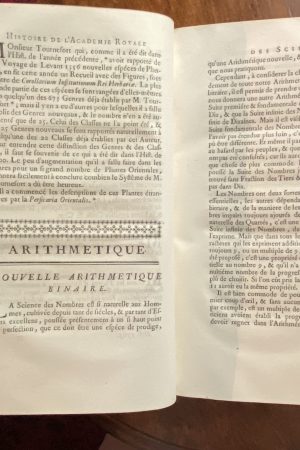LAPLACE 1796
- Description
Description
Laplace, Traité de mécanique céleste, 5 vol., Paris, Duprat, 1796
Folding engraved plate in Vol. IV. Five vols. Large 4to, cont. polished mottled calf (joints & a few corners carefully repaired), spines nicely gilt, red morocco lettering pieces on spines. First edition and a complete set with all the supplements.
In this monumental and fundamental astronomical work, Laplace — the “Newton of France” — codified and developed the theories and achievements of Newton, Euler, d’Alembert, and Lagrange. “Laplace maintained that while all planets revolve round the sun their eccentricities and the inclinations of their orbits to each other will always remain small. He also showed that all these irregularities in movements and positions in the heavens were self-correcting, so that the whole solar system appeared to be mechanically stable. He showed that the universe was really a great self-regulating machine and the whole solar system could continue on its existing plan for an immense period of time. This was a long step forward from the Newtonian uncertainties in this respect … Laplace also offered a brilliant explanation of the secular inequalities of the mean motion of the moon about the earth — a problem which Euler and Lagrange had failed to solve … He also investigated the theory of the tides and calculated from them the mass of the moon.”–Printing & the Mind of Man 252. A very nice set. Our set has the first state, with the earlier dates, of the titles of Vols. I and II, all the half-titles, and all the supplements.
Bibliography: Dibner, Heralds of Science, 14. d.s.b., XV, pp. 273-403. En Français dans le Texte 201. Horblit 63. Roberts & Trent, Bibliotheca Mechanica, pp. 197-98.
Pierre-Simon, Marquis de Laplace (1749 –1827) was a French scholar and polymath whose work was important to the development of engineering, mathematics, statistics, physics, astronomy, and philosophy. He summarized and extended the work of his predecessors in his five-volume Mécanique céleste (Celestial Mechanics) (1799–1825). This work translated the geometric study of classical mechanics to one based on calculus, opening up a broader range of problems. In statistics, the Bayesian interpretation of probability was developed mainly by Laplace.
Laplace formulated Laplace’s equation, and pioneered the Laplace transform which appears in many branches of mathematical physics, a field that he took a leading role in forming. The Laplacian differential operator, widely used in mathematics, is also named after him. He restated and developed the nebular hypothesis of the origin of the Solar System and was one of the first scientists to suggest an idea similar to that of a black hole.
Laplace is regarded as one of the greatest scientists of all time. Sometimes referred to as the French Newton or Newton of France, he has been described as possessing a phenomenal natural mathematical faculty superior to that of almost all of his contemporaries. He was Napoleon’s examiner when Napoleon graduated from the École Militaire in Paris in 1785. Laplace became a count of the Empire in 1806 and was named a marquis in 1817, after the Bourbon Restoration.
Please contact us for more information here












